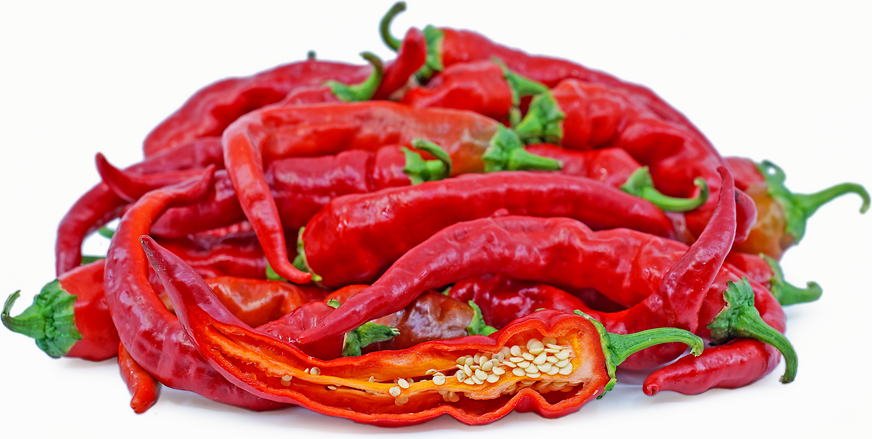


Tunisian Baklouti Peppers
Estimated Inventory, lb : 0
Description/Taste
Tunisian Baklouti peppers are large, slightly curved pods, averaging 15 to 20 centimeters in length, and have a conical shape that tapers to a pointed tip on the non-stem end. The skin is glossy, waxy, tough, and creased, ripening from green to bright red when mature. Underneath the surface, the flesh is thin, crisp, aqueous, and pale red, encasing a central cavity filled with small, cream-colored seeds. Tunisian Baklouti peppers are chewy with a mild, sweet, and fruity flavor followed by a mellow tinge of heat.
Seasons/Availability
Tunisian Baklouti peppers are available in the summer through fall.
Current Facts
Tunisian Baklouti peppers, botanically classified as Capsicum annuum, are a sweet pepper variety that belongs to the Solanaceae or nightshade family. The bright red peppers were once historically localized to Tunisia in Northern Africa, but with trade, expansion, and advances from the Roman Empire, Tunisian Baklouti peppers were spread along the Barbary Coast and cultivated in fertile soils. Tunisian Baklouti peppers are sweet with a very mild heat, ranging 1,000-5,000 SHU on the Scoville scale, and are a favored cooking pepper in North Africa.
Nutritional Value
Tunisian Baklouti peppers are an excellent source of vitamin C, which is an antioxidant that can help protect the immune system and increase collagen production within the body. The peppers also contain folate, vitamins A, B6, and E, and potassium.
Applications
Tunisian Baklouti peppers are best suited for both raw and cooked applications such as roasting, sautéing, and stir-frying. The peppers can be sliced and tossed into salads, chopped into salsas and sauces, infused into oils for added flavor, pickled for extended use, or dried and ground into a powder. Tunisian Baklouti peppers can also be stuffed with legumes, grains, or meats, mixed into soups, curries, and stews, or lightly stir-fried with other vegetables. In Tunisia, the peppers are incorporated into shakshuka, which is a stew-like dish made with a mixture of ingredients such as eggs, pepper, tomatoes, onions, and garlic. Tunisian Baklouti peppers are also used to flavor lablabi, which is a soup made from spices, pepper paste, and chickpeas, and is often poured over a bowl of torn bread to absorb the flavorful broth. Tunisian Baklouti peppers pair well with meats such as beef, lamb, and poultry, eggs, tuna, other seafood, tomatoes, potatoes, squash, cucumbers, radishes, apples, dates, and lemon juice. The fresh peppers will keep 1-2 weeks when loosely stored whole and unwashed in a plastic or paper bag in the refrigerator.
Ethnic/Cultural Info
North Africa was seen as the Roman Empire’s breadbasket, and with increased agriculture, new preservation techniques were created to extend the shelf life of produce. Tunisian Baklouti peppers are most famous for their use in harissa, which is a sauce-like condiment made from ground chile peppers, olive oil, and salt. The name harissa is derived from the Arabic word harasa, which roughly translates to mean “break into pieces” or “to pound.” Harissa is considered to be Tunisia’s national condiment and is sold premade in jars or is made fresh in local markets known as souks. There are many different variations of harissa with added ingredients such as roses, onions, or lemon juice, and the condiment is served at every meal, especially alongside meat dishes, couscous, curries, and stews. Harissa has also become popular worldwide, with acclaimed chefs and food bloggers promoting it as a “new Sriracha.”
Geography/History
Tunisian Baklouti peppers are descendants of original pepper varieties native to South America that have been cultivated since ancient times. The original peppers were introduced to North Africa by Spanish and Portuguese colonizers in the 15th and 16th centuries, and the peppers were naturally bred to develop the Tunisian Baklouti peppers seen in markets in the modern-day. Tunisian Baklouti peppers can be found in home gardens and at local markets throughout North Africa, especially in Tunisia. Outside of Africa, the peppers are considered to be somewhat rare and are also grown in home gardens of pepper enthusiasts around the world, including the United States, Europe, and Australia.
Recipe Ideas
Recipes that include Tunisian Baklouti Peppers. One
| All Recipes |
|
Tunisian Harissa |




